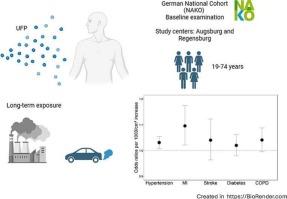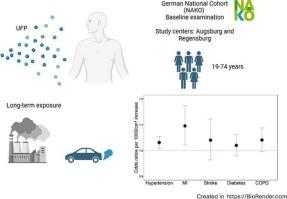Long-term exposure to ultrafine particles and its association with cardiometabolic diseases, chronic obstructive pulmonary disease, and cardiometabolic biomarkers: A cross-sectional analysis of the German National cohort (NAKO)
IF 9.7
1区 环境科学与生态学
Q1 ENVIRONMENTAL SCIENCES
引用次数: 0
Abstract
There is limited epidemiological evidence regarding the health effects of ultrafine particles (UFP; particles with an aerodynamic diameter of 10–100 nm). This study investigated whether long-term exposure to total particle number concentration (PNC), used as a surrogate for UFP, is associated with cardiometabolic diseases, chronic obstructive pulmonary disease (COPD), and cardiometabolic biomarkers.
Our cross-sectional study included 27,390 participants of the NAKO study centers in Augsburg and Regensburg in Southern Germany. Health outcomes included self-reported, physician-diagnosed diseases such as hypertension, myocardial infarction, or COPD, alongside blood biomarkers such as glucose. Annual PNC averages for 2014 were estimated using supervised land use regression models and linked to participants’ home addresses. We also obtained annual averages of further pollutants (e.g., particulate matter ≤ 2.5 µm (PM2.5)) for 2010. We applied covariate-adjusted logistic and linear regression models to examine associations between PNC and health outcomes. Additionally, we assessed interdependencies between pollutants using two-pollutant models.
Long-term exposure to PNC was associated with increased odds of hypertension and myocardial infarction, and COPD, as well as elevated glucose and leukocyte levels. For example, the odds ratio for hypertension was 1.03 (95% confidence interval: 1.01;1.05) for each increase in PNC by 1000 particles/cm3. Two-pollutant models did not substantially change the results for PNC but led to slightly wider confidence intervals.
In conclusion, our study suggests that long-term exposure to PNC, as a surrogate for UFP, contributes to the risk of hypertension, myocardial infarction, COPD, and elevated blood glucose and leukocyte levels in adults. These results highlight the role of UFP within the broader mixture of ambient air pollution and underscore the need for strategies to reduce UFP exposure to prevent adverse cardiometabolic and pulmonary health effects.


长期暴露于超细颗粒及其与心脏代谢疾病、慢性阻塞性肺疾病和心脏代谢生物标志物的关系:德国国家队列(NAKO)的横断面分析
关于超细颗粒(UFP;空气动力学直径为10-100 纳米的颗粒)对健康的影响,流行病学证据有限。这项研究调查了长期暴露于总颗粒数浓度(PNC),作为UFP的替代指标,是否与心脏代谢疾病、慢性阻塞性肺疾病(COPD)和心脏代谢生物标志物相关。我们的横断面研究包括27,390名来自德国南部奥格斯堡和雷根斯堡的NAKO研究中心的参与者。健康结果包括自我报告的、医生诊断的疾病,如高血压、心肌梗死或慢性阻塞性肺病,以及血糖等血液生物标志物。2014年的年度PNC平均值使用监督土地使用回归模型进行估算,并与参与者的家庭住址相关联。我们还获得了2010年其他污染物(例如,颗粒物 ≤ 2.5 µm (PM2.5))的年平均值。我们应用协变量校正逻辑模型和线性回归模型来检验PNC与健康结果之间的关系。此外,我们使用双污染物模型评估了污染物之间的相互依赖性。长期暴露于PNC与高血压、心肌梗死、慢性阻塞性肺病以及血糖和白细胞水平升高的几率增加有关。例如,PNC每增加1000个颗粒/cm3,高血压的比值比为1.05(95%可信区间:1.02;1.08)。双污染物模型并没有实质性地改变PNC的结果,但导致置信区间略宽。总之,我们的研究表明,长期暴露于PNC,作为UFP的替代品,会增加成人高血压、心肌梗死、COPD、血糖和白细胞水平升高的风险。这些结果突出了UFP在更广泛的环境空气污染混合物中的作用,并强调需要采取策略减少UFP暴露,以防止不利的心脏代谢和肺部健康影响。
本文章由计算机程序翻译,如有差异,请以英文原文为准。
求助全文
约1分钟内获得全文
求助全文
来源期刊

Environment International
环境科学-环境科学
CiteScore
21.90
自引率
3.40%
发文量
734
审稿时长
2.8 months
期刊介绍:
Environmental Health publishes manuscripts focusing on critical aspects of environmental and occupational medicine, including studies in toxicology and epidemiology, to illuminate the human health implications of exposure to environmental hazards. The journal adopts an open-access model and practices open peer review.
It caters to scientists and practitioners across all environmental science domains, directly or indirectly impacting human health and well-being. With a commitment to enhancing the prevention of environmentally-related health risks, Environmental Health serves as a public health journal for the community and scientists engaged in matters of public health significance concerning the environment.
 求助内容:
求助内容: 应助结果提醒方式:
应助结果提醒方式:


